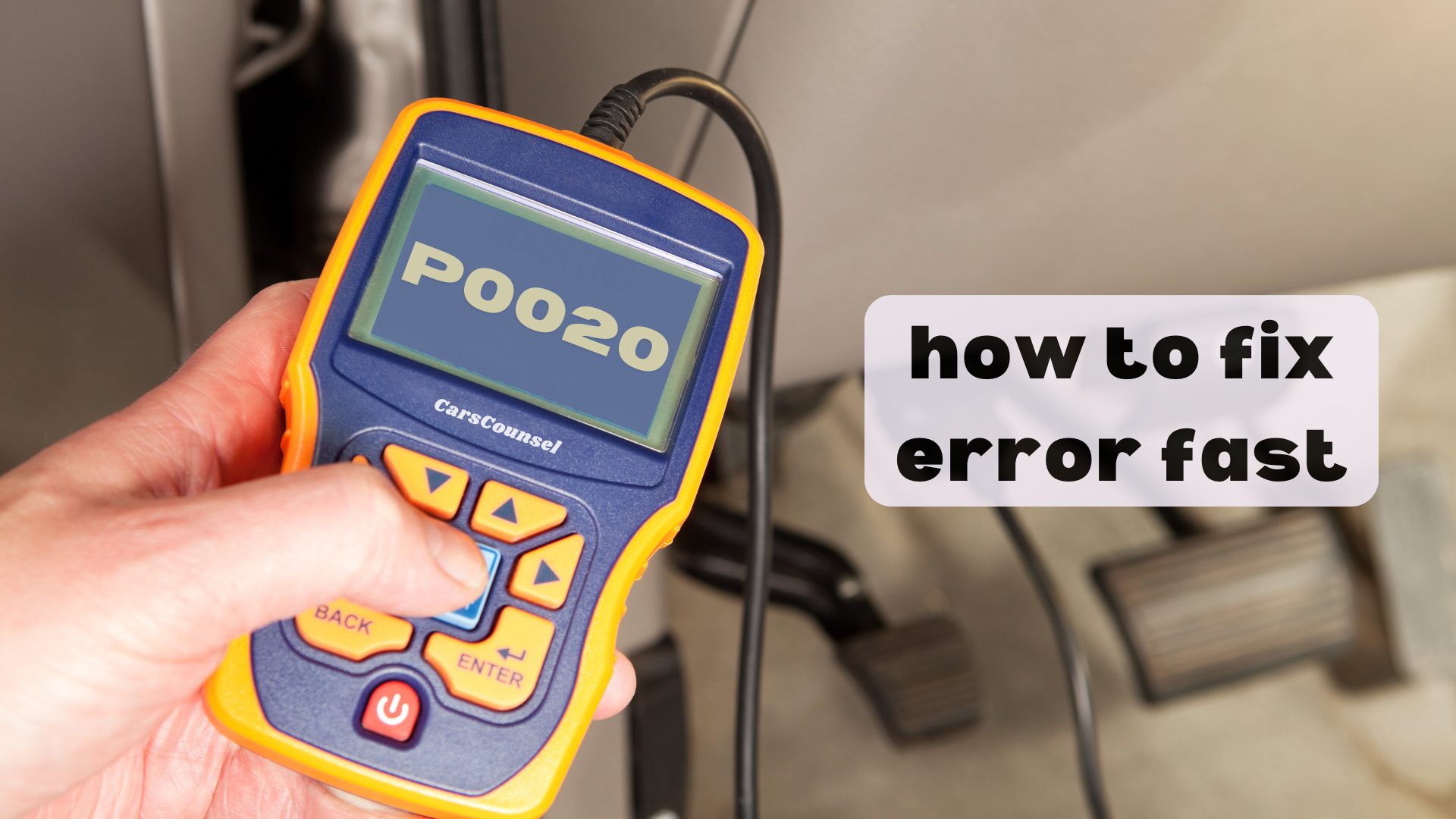Fixing a P0020 code might seem tricky, but it’s actually doable with the right steps.
First, get an OBD-II scanner to confirm the OBD2 code and check the camshaft position actuator and VVT sensor.
Look at the wiring for any damage or rust, and use a multimeter to check the VVT solenoid’s resistance.
Make sure your engine oil is clean and at the right level since it’s crucial for VVT to work properly.
Want to know exactly how to do these checks and repairs? Let’s dive in.

Quick Navigation
Key Takeaways
- Use an OBD-II scanner to confirm the P0020 code and find out what might be causing it.
- Look for any damage, rust, or loose connections in the wiring and connectors, and fix them if needed.
- Test the VVT solenoid and replace it if the resistance readings are not what the manufacturer suggests.
- Check the engine oil levels and condition; change the oil if it’s necessary.
Understanding P0020 Code
The P0020 code indicates a problem with the camshaft position actuator circuit, which is often related to the Variable Valve Timing (VVT) sensor. This issue can affect your engine’s performance.
To understand it better, you need to know that the camshaft actuator adjusts the camshaft position to optimize engine timing. This adjustment helps your engine run more efficiently and powerfully.
When you see the P0020 code, it means the actuator mightn’t be working properly. Start by checking the VVT sensor and the wiring connected to it. Make sure there’s no damage or corrosion.
Use a diagnostic tool to confirm the code and check the resistance of the camshaft actuator. Regular inspections and using good-quality parts can help prevent this problem from happening again. Proper diagnosis will make troubleshooting and fixing the issue easier.
Common Symptoms
If your car is idling roughly and the engine misfires, it could be due to a P0020 code issue. You might notice the engine doesn’t perform well, including slower acceleration and less power. The Check Engine Light (CEL) will turn on, warning you of the problem.
Rough idling is especially noticeable when you start the car, and you might hear unusual engine noises. Your car may also produce more emissions, which can cause it to fail smog tests.
These signs mean the engine’s Variable Valve Timing (VVT) system isn’t working right. Paying attention to these symptoms can help you catch the problem early and get it fixed in time, ensuring your engine runs smoothly and avoiding more serious damage.
Primary Causes
To figure out what’s causing a P0020 code in your car, you’ll need to check a few key parts in the engine’s Variable Valve Timing (VVT) system.
Start with the camshaft actuator, which is often the main problem. See if it’s worn out or damaged.
Then, look at the wiring and connectors to make sure they’re not corroded or broken.
Also, check the timing chain. If the tensioner is bad or the chain is loose, it can mess up the alignment and trigger the code.
Extreme weather can make these problems worse.
Diagnostic Tools
To fix the main issues behind a P0020 code, you’ll need some diagnostic tools like an OBD-II scanner.
Start by plugging the scanner into your car’s diagnostic port, which is usually under the dashboard. Use the scanner to get the P0020 code and any other related codes.
Then, use diagnostic software to understand what the code means and what might be causing it. The software can show real-time data on the camshaft position and VVT sensor performance.
This step-by-step check helps you find the exact problem, whether it’s a bad actuator, a wiring issue, or something else.
Accurate diagnostics make sure you fix the real problem, saving you time and money on repairs.
Inspect Wiring and Connectors
When checking the wiring and connectors, start by looking for any damage, rust, or loose connections.
Begin at the camshaft position actuator and follow the wires back to the Engine Control Module (ECM). Check for any frayed wires, exposed copper, or melted insulation. If you spot any problems, fix the wiring as needed.
Then, unplug each connector and check the pins for rust or dirt. Clean them with electrical contact cleaner if necessary. Make sure the connectors snap back in place securely to keep a strong connection.
Regularly maintaining the connectors can help avoid electrical issues.
Once you’ve done all this, clear the P0020 code and test the engine to make sure the problem is fixed.
Check VVT Solenoid
After checking the wiring and connectors, you should test the VVT solenoid to make sure it’s working properly. Start by unplugging the VVT solenoid’s electrical connector. Then, use a multimeter to measure the resistance across the solenoid terminals. Compare your readings to the numbers given by the manufacturer.
Steps to Test the Solenoid
| Step | Action | Tool Needed |
|---|---|---|
| 1 | Unplug the VVT solenoid connector | Your hands |
| 2 | Measure resistance across solenoid terminals | A multimeter |
| 3 | Compare readings with manufacturer’s specs | A multimeter |
If the resistance is not within the specified range, the solenoid might be faulty and you’ll need to replace it. Proper VVT function is crucial for preventing rough idling and poor engine performance.
Review Engine Oil
Make sure to check the engine oil levels and quality because low or dirty oil can mess with the Variable Valve Timing (VVT) system.
First, find the dipstick and pull it out. Wipe it clean, put it back in, and then pull it out again to check the oil level. Make sure it’s within the recommended range.
Look at the oil’s condition; it should be amber and clear. If it’s dark or gritty, change the oil and filter right away.
Use the correct oil viscosity listed in your vehicle’s manual to keep the engine running smoothly.
Regularly checking and maintaining proper oil levels and quality helps prevent P0020 code triggers and ensures smooth VVT operation.
Fixing Wiring Issues
Now that you’ve made sure the engine oil is in good shape, take a look at the wiring and connectors to see if there’s any damage or rust.
Follow these steps to check the electrical system:
- Look Over Everything: Examine all the wires and connectors connected to the camshaft position actuator. Check for any wires that are worn out, loose connections, or rust.
- Check the Wires: Use a multimeter to test the wires. Make sure electricity can flow through without interruption.
- Clean the Connectors: If you find any rusty connectors, clean them well with electrical contact cleaner and a small brush.
Replacing Faulty Components
How to Replace Faulty Components
First, identify and remove the faulty camshaft position actuator or VVT solenoid using the right tools for your car. Make sure the new part matches your vehicle’s specifications by checking your car’s manual for detailed instructions.
| Step | Description |
|---|---|
| 1 | Disconnect the battery to prevent electrical problems. |
| 2 | Carefully remove the faulty part, noting where each connector goes. |
| 3 | Install the new part, ensuring it fits securely. |
Here are some tips for installation: double-check all connections, follow the recommended torque settings, and avoid over-tightening. After installing the new part, reconnect the battery and use an OBD-II scanner to clear the P0020 code. Take your car for a test drive to make sure the problem is fixed.
Preventive Measures
Changing your engine oil and filter regularly is key to preventing the P0020 error code and ensuring your VVT system runs smoothly. Keeping up with maintenance is crucial for your engine’s best performance.
Follow these steps to lower the chance of running into the P0020 code:
- Regular Oil Changes: Change your engine oil and filter every 3,000-5,000 miles to keep the VVT system properly lubricated and working well.
- Regular Check-Ups: Look at the VVT solenoid, camshaft position actuator, and related wiring often to see if they’re worn out or damaged.
- Use Good Parts: Always use high-quality parts when making replacements to keep the system strong and lasting.
Doing these things will help your engine run smoothly and prevent future problems.
More OBD-II Codes
Frequently Asked Questions
Can Driving With a P0020 Code Damage My Engine Long-Term?
Driving with a P0020 code can harm your engine over time. Poor engine performance and bad oil quality can cause more wear and tear. Fix any wiring, connectors, or the VVT solenoid quickly to keep your engine running well.
How Much Does It Typically Cost to Fix a P0020 Code?
Fixing a P0020 code usually costs between $150 and $500. This includes the cost for the mechanic to figure out what’s wrong and the cost to fix it. First, get a price for the diagnostic check, then add in parts and labor to get a clear idea of the total cost.
Are There DIY Solutions for Fixing the P0020 Code?
Yes, you can try fixing it yourself. Start by checking the wiring and connectors. Clean the VVT sensor, look at the camshaft actuator, and replace any broken parts. These steps can help fix the P0020 code.
Can a P0020 Code Affect My Car’s Fuel Economy Significantly?
Yes, a P0020 code can really hurt your car’s gas mileage. You’ll see a big drop in power and the engine may run rough. Fixing it quickly will help get your fuel economy and engine performance back to normal.
How Long Does It Usually Take to Repair a P0020 Code Issue?
It usually takes about 1-3 hours to fix the issue. The process includes checking the wiring, connectors, and the VVT solenoid. If any parts need replacing, it might take a bit longer.
Conclusion
By quickly addressing the P0020 code, you can keep your engine running smoothly and prevent long-term damage.
Use an OBD-II scanner to check the code, inspect the wiring, and check the VVT solenoid.
Make sure your engine oil is clean, as it’s important for VVT functionality.
Fix any wiring issues and replace any faulty parts right away.
This will help your engine perform its best and avoid bigger problems later.
Taking quick action now means fewer headaches down the road.

